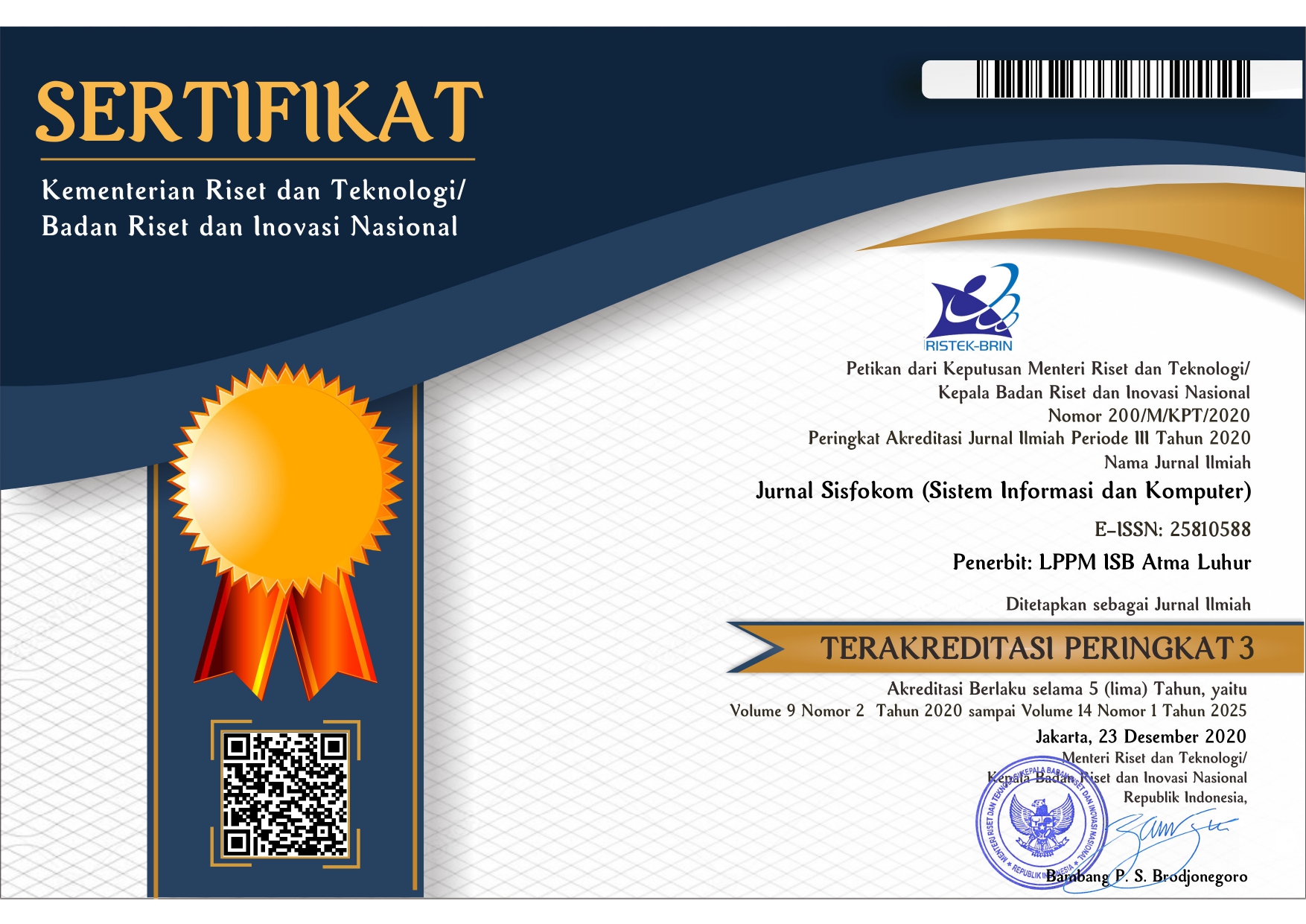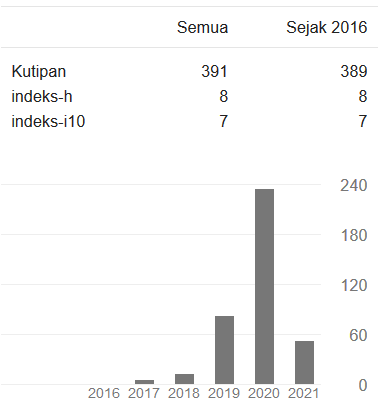Metode Klasifikasi Gejala Penyakit Coronavirus Disease 19 (COVID-19) Menggunakan Algoritma Neural Network
DOI:
https://doi.org/10.32736/sisfokom.v12i1.1406Keywords:
Covid-19, Neural Network, Logistic Regression, klasifikasi, CRISP-DMAbstract
Coronavirus Disease 19 (COVID-19) adalah virus baru yang dapat menyebabkan infeksi saluran pernafasan. Virus ini berasal dari hewan yang dapat menular ke manusia melalui percikan ludahnya. Menurt data epidemiologis, rata-rata penderita virus ini berusia 15-80 tahun. Virus ini memiliki masa inkubasi 3-14 hari yang memiliki gejala awal yaitu demam tinggi, sesak napas, batuk dan pilek. Indonesia mwmiliki 2 kasus pertama pada 2 Maret 2020, Covid-19 meningkat secara teratur pada 29 Desember 2020 data menunjukkan 719.219 ribu orang dipastikan terjangkit Covid-19. Masalah yang diangkat dalam penelitian ini adalah bagaimana mengklasifikasikan risiko tertular virus Covid-19 dari gejala yang ditimbulkan. Tujuan dari penelitian ini adalah untuk mengetahui nilai akurasi dari klasifikasi resiko tertular virus Covid-19 berdasarkan instrument yang digunkan dari metode Cross Industry Standard Process for Data Mining (CRISP-DM). Dataset yang digunakan peniliti diambil dari website http://github.com/nshomron/covidpred. Penelitian ini menggunakan Algoritma Neural Network (NN) dengan bantuan alat Phyton, akurasi Algoritma Neural Ntwork (NN) diperoleh nilai sebesar 95%, artinya telah menunjukkan hasil klasifikasi yang baik. Peneliti juga menguji dengan Algoritma Logistic Regression namun nilai akurasi yang diperoleh tidak jauh berbeda dengan Algoritma NN, Algoritma Logistic Regression diperoleh akurasi nilai sebesar 94%.References
Abdillah, G., Putra, F. A., Renaldi, F., Informatika, P. S., Jenderal, U., & Yani, A. (2016). Penerapan Data Mining Pemakaian Air Pelanggan Untuk Menentukan Klasifikasi Potensi Pemakaian Air Pelanggan Baru Di Pdam Tirta Raharja Menggunakan Algoritma K-Means. Seminar Nasional Teknologi Informasi Dan Komunikasi, 2016, 18–19.
Abdillah, L. (2020). Stigma Terhadap Orang Positif COVID-19 (Stigma on Positive People COVID-19). Pandemik COVID-19: Antara Persoalan Dan Refleksi Di Indonesia, Forthcoming.
Ahmad, A. (2017). Mengenal artificial intelligence, machine learning, neural network, dan deep learning. J. Teknol. Indones, 3.
Ayumi, V., & Nurhaida, I. (2021). Klasifikasi Chest X-Ray Images Berdasarkan Kriteria Gejala Covid-19 Menggunakan Convolutional Neural Network. JSAI (Journal Scientific and Applied Informatics), 4(2), 147– 153.
Behrens, J. T. (1997). Principles and procedures of exploratory data analysis. Psychological Methods, 2(2), 131. Fadillah, A. P. (2015). Penerapan Metode CRISP-DM untuk Prediksi Kelulusan Studi Mahasiswa Menempuh Mata Kuliah (Studi Kasus Universitas XYZ). Jurnal Teknik Informatika Dan Sistem Informasi, 1(3).
Rifai, B. (2013). Algoritma Neural Network Untuk Prediksi Penyakit Jantung. Techno Nusa Mandiri: Journal of Computing and Information Technology, 10(1), 1–9.
Saifudin, A. (2018). Metode Data Mining untuk Seleksi Calon Mahasiswa pada Penerimaan Mahasiswa Baru di Universitas Pamulang. Jurnal Teknologi, 10(1), 25–36.
Saputro, W. T., & Jumasa, H. M. (2018). Memprediksi Daftar Ulang Mahasiswa Baru Menggunakan Algoritma Bayesian Classification Di Universitas XYZ. INTEK: Jurnal Informatika Dan Teknologi Informasi, 1(2), 73– 82.
Sutoyo, I. (2018). Implementasi Algoritma Decision Tree Untuk Klasifikasi Data Peserta Didik. Pilar Nusa Mandiri: Journal of Computing and Information System, 14(2), 217–224.
Windarto, A. P., Lubis, M. R., & Solikhun, S. (2018). Model Arsitektur Neural Network Dengan Backpropogation Pada Prediksi Total Laba Rugi Komprehensif Bank Umum Konvensional. Klik-Kumpulan Jurnal Ilmu Komputer, 5(2), 147–158.
Yuliana, D., Purwanto, P., & Supriyanto, C. (2018). Klasifikasi Teks Pengaduan Masyarakat Dengan Menggunakan Algoritma Neural Network. Jurnal KomTekInfo, 5(3), 92–116.
Downloads
Additional Files
- Metode Klasifikasi Gejala Penyakit Coronavirus Disease 19 (COVID-19) Menggunakan Algoritma Neural Network
- Metode Klasifikasi Gejala Penyakit Coronavirus Disease 19 (COVID-19) Menggunakan Algoritma Neural Network
- METODE KLASIFIKASI GEJALA PENYAKIT CORONAVIRUS DISEASE 19 (COVID-19) MENGGUNAKAN ALGORITMA NEURAL NETWORK
- METODE KLASIFIKASI GEJALA PENYAKIT CORONAVIRUS DISEASE 19 (COVID-19) MENGGUNAKAN ALGORITMA NEURAL NETWORK
Published
Issue
Section
License
The copyright of the article that accepted for publication shall be assigned to Jurnal Sisfokom (Sistem Informasi dan Komputer) and LPPM ISB Atma Luhur as the publisher of the journal. Copyright includes the right to reproduce and deliver the article in all form and media, including reprints, photographs, microfilms, and any other similar reproductions, as well as translations.
Jurnal Sisfokom (Sistem Informasi dan Komputer), LPPM ISB Atma Luhur, and the Editors make every effort to ensure that no wrong or misleading data, opinions or statements be published in the journal. In any way, the contents of the articles and advertisements published in Jurnal Sisfokom (Sistem Informasi dan Komputer) are the sole and exclusive responsibility of their respective authors.
Jurnal Sisfokom (Sistem Informasi dan Komputer) has full publishing rights to the published articles. Authors are allowed to distribute articles that have been published by sharing the link or DOI of the article. Authors are allowed to use their articles for legal purposes deemed necessary without the written permission of the journal with the initial publication notification from the Jurnal Sisfokom (Sistem Informasi dan Komputer).
The Copyright Transfer Form can be downloaded [Copyright Transfer Form Jurnal Sisfokom (Sistem Informasi dan Komputer).
This agreement is to be signed by at least one of the authors who have obtained the assent of the co-author(s). After submission of this agreement signed by the corresponding author, changes of authorship or in the order of the authors listed will not be accepted. The copyright form should be signed originally, and send it to the Editorial in the form of scanned document to sisfokom@atmaluhur.ac.id.









